Gait Movement Science: Detailed Terminology and Definitions for Understanding Gait Mechanics
1/73
There's no tags or description
Looks like no tags are added yet.
Name | Mastery | Learn | Test | Matching | Spaced |
|---|
No study sessions yet.
74 Terms
RLA initial contact
0%
When the foot makes initial contact with the ground.

RLA loading response
2% - 12%
Following Initial contact until the opposite foot leaves the ground (occurs during the first double limb support time of the gait cycle)
Consists of eccentric control for "shock absorption"
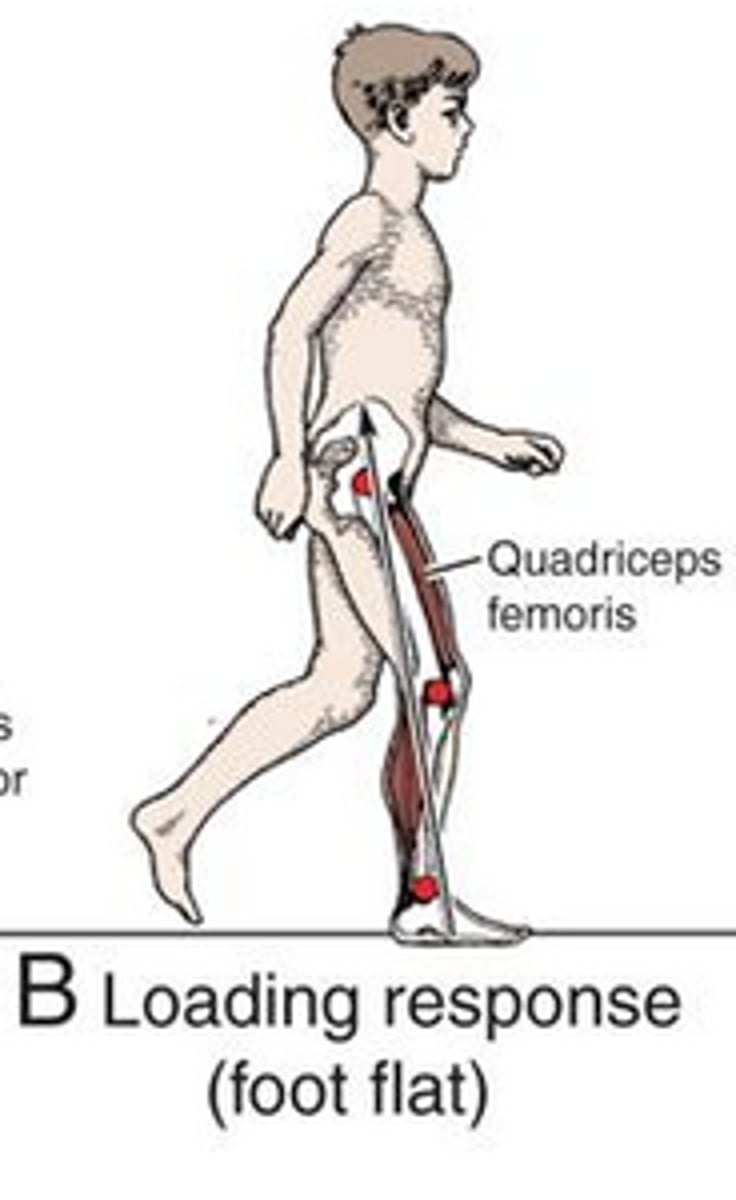
RLA mid stance
12 - 30%
Begins at beginning of Single Limb Support and when Trunk is behind vertical line of ankle.
Ends when trunk is in front of vertical line of ankle and when heel rises (beginning of terminal stance
Important for Weight Acceptance
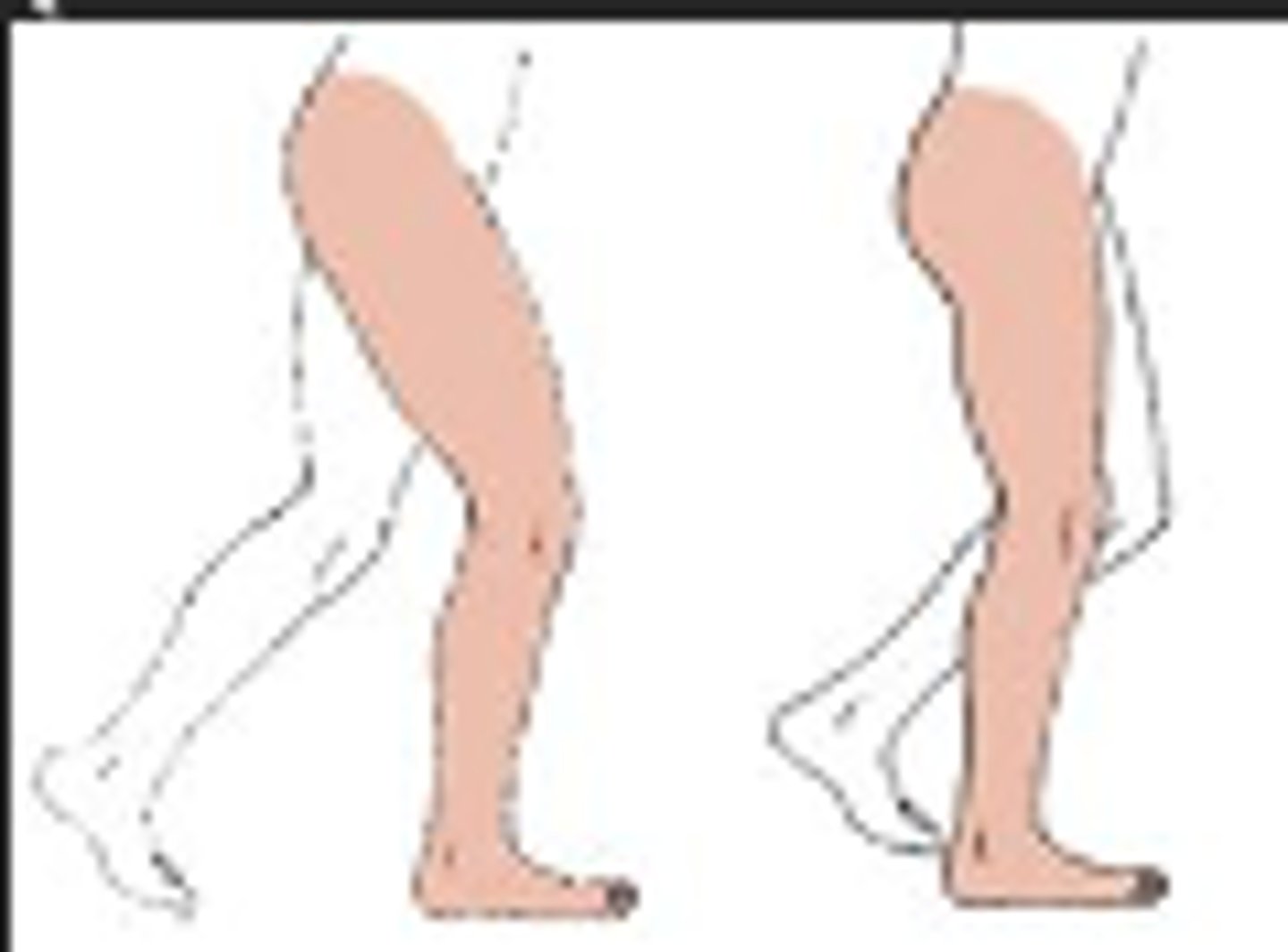
RLA Terminal Stance
30-50%
Begins when the heel lifts off the ground
Ends when entering double limb support Important for forward propulsion.
Gastroc and Soleus play an important role.
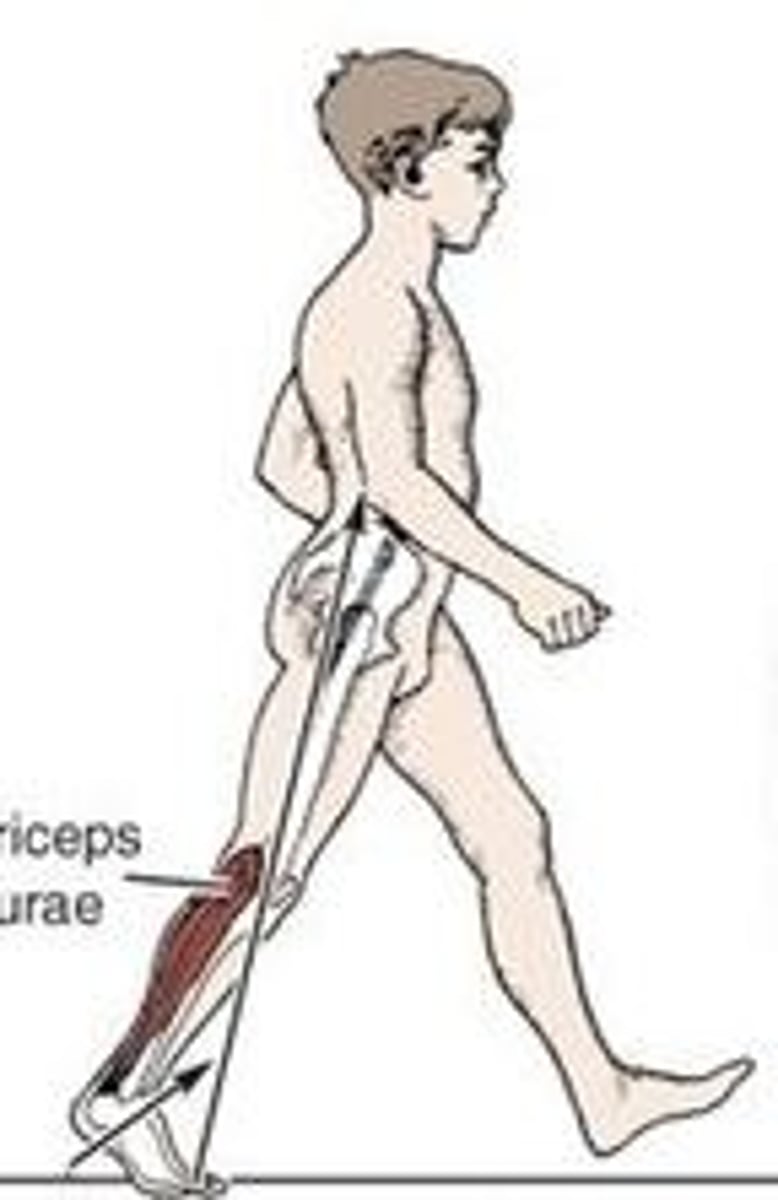
RLA pre swing
50-60%
Begins at the beginning of the second double limb support.
Ends when the toe clears off the ground of the reference limb.
Important for getting the reference limb into a "Trailing Limb Posture". This is an important position to begin the sudden change in direction of lower extremity flexion for early swing phase of gait.
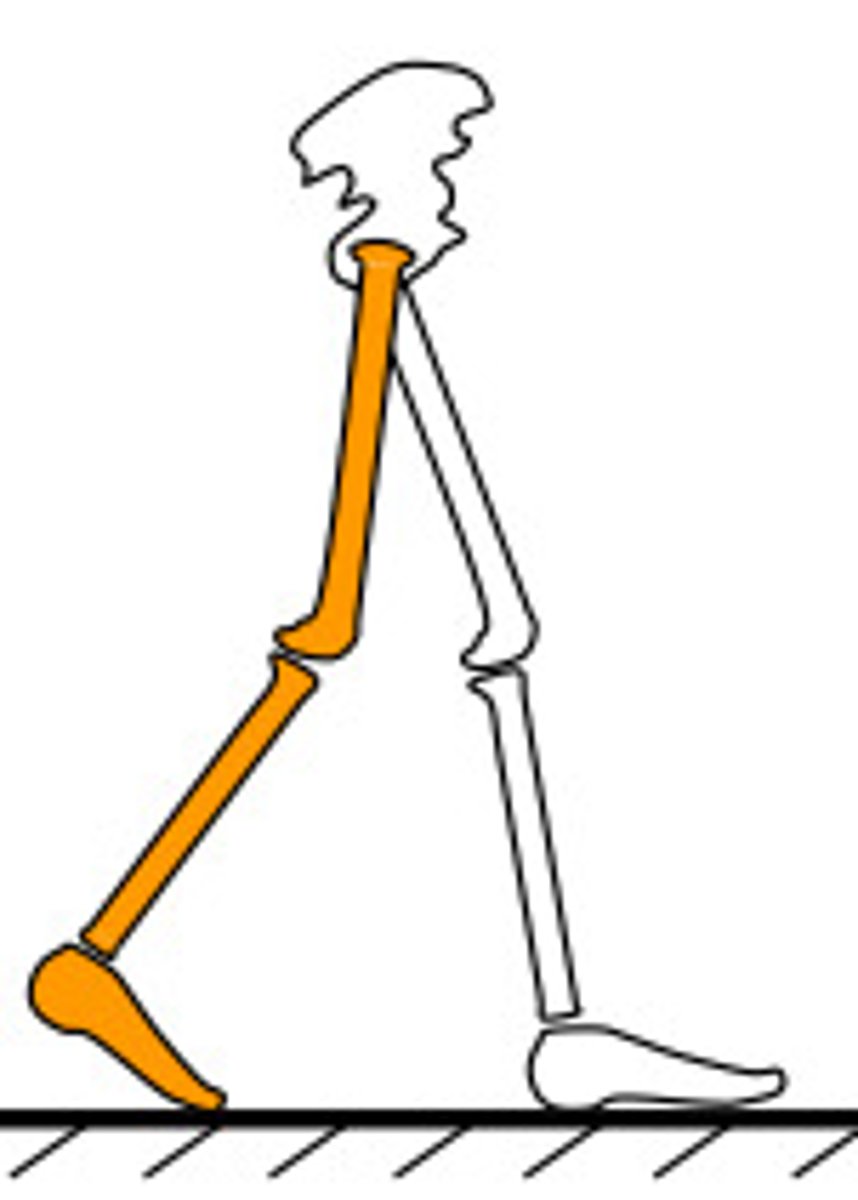
RLA Initial swing
60-75%
When the foot first leaves the ground the knee and hip move into greater flexion.
Initial swing continues until the foot is next to the opposite leg.
At this point, the knee begins to straighten.
Important for clearance of the foot through swing limb advancement.
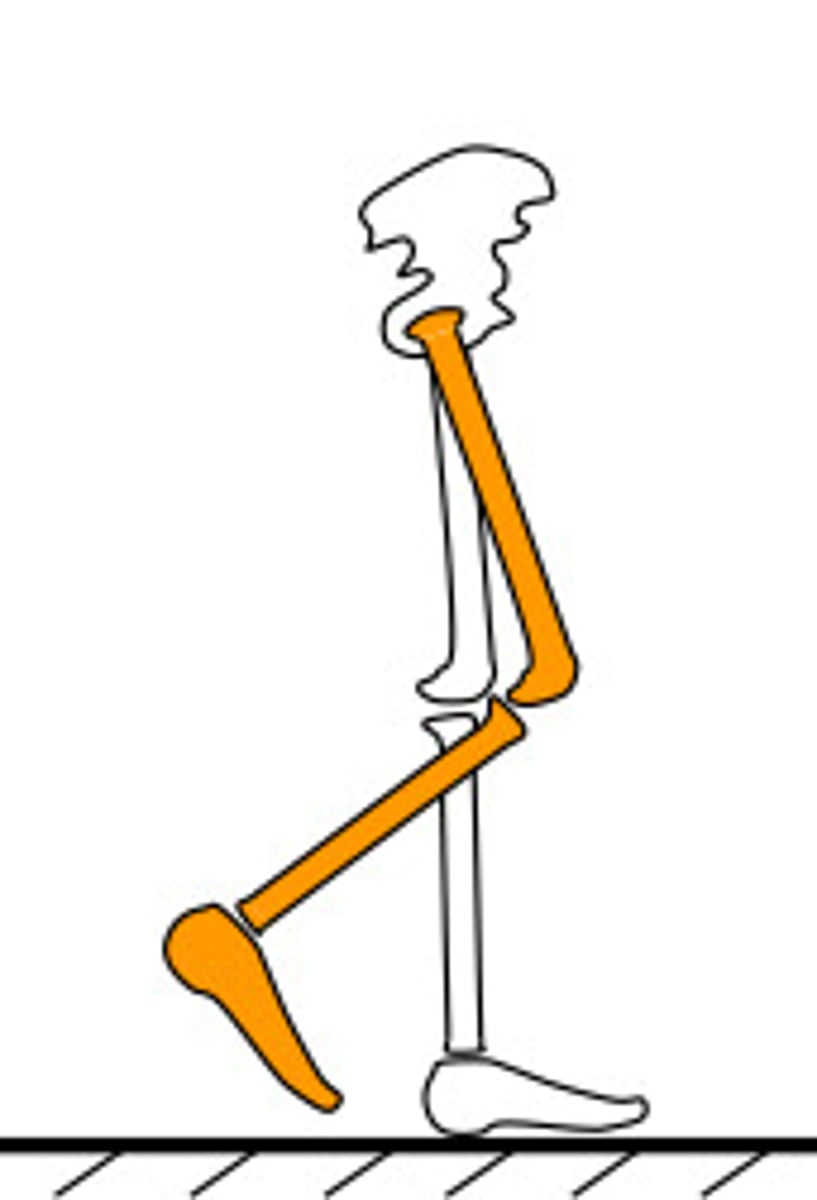
RLA Mid swing
75-87%
Begins when the foot is next to the opposite limb, and the knee begins to extend while the hip is flexed.
Important for clearance of the foot through swing limb advancement.
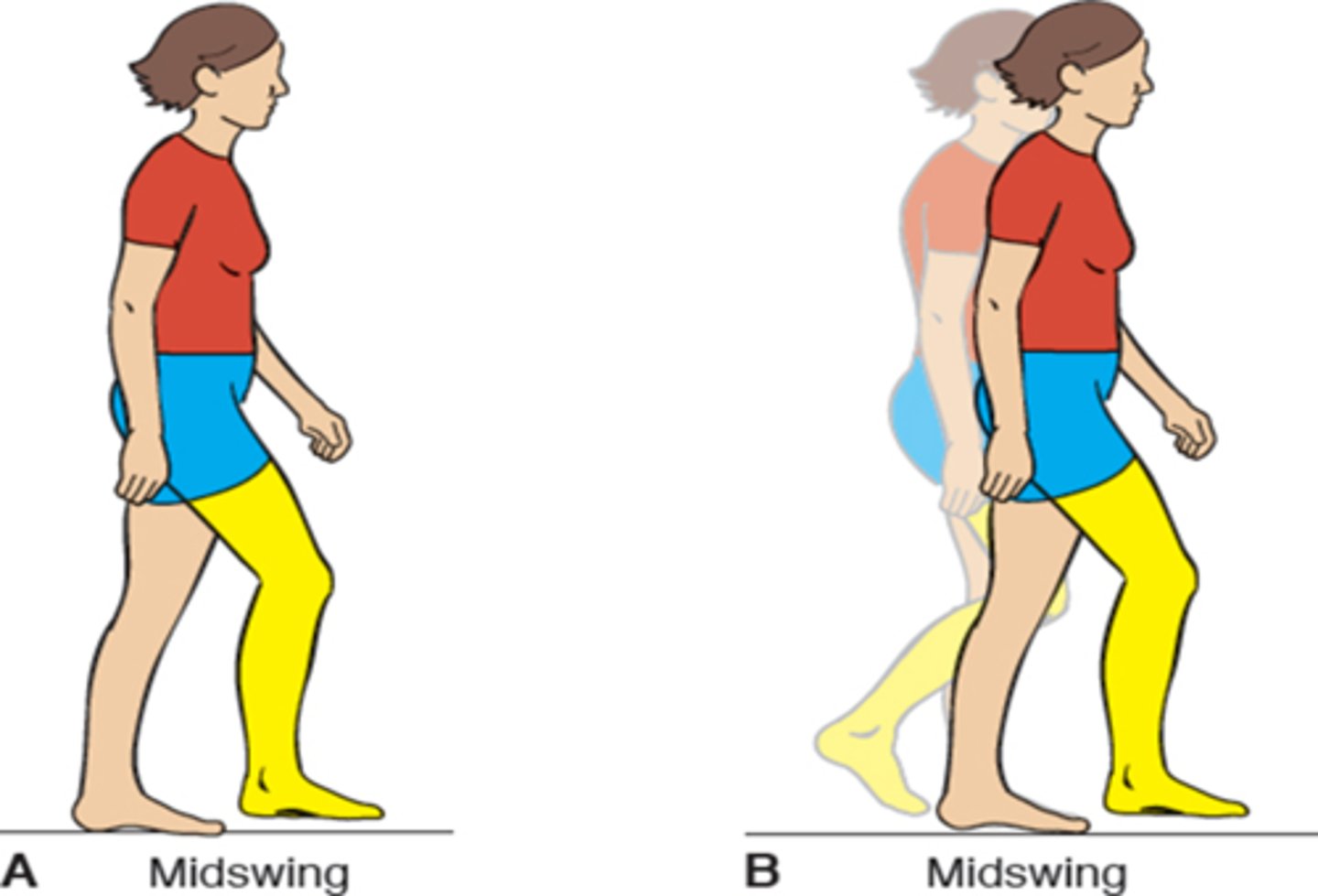
RLA terminal swing
87 - 100%
The last phase of swing in which the hip initially is flexed, and the knee is extended, allowing for the foot to be in front, ready to obtain the forward placed foot for initial contact, to begin the next gait cycle.
Just prior to initial contact, the hip extends, lowering the foot into place for initial contact.
Important for preparing the foot to be placed in front for the next cycle of gait.
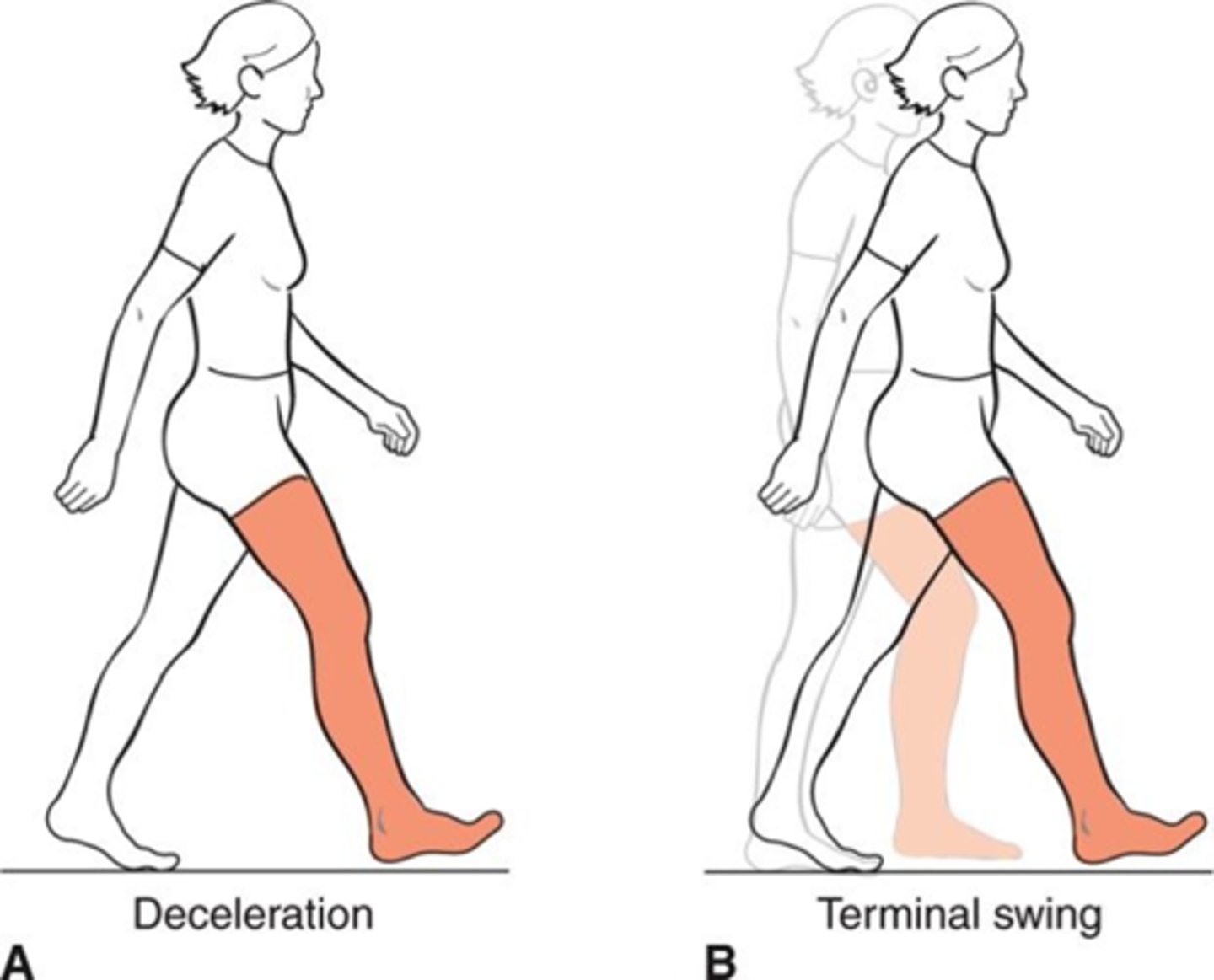
Traditional Method Phases
-Heel strike
-Foot flat
-Midstance
-Heel Off
-Toe Off
Swing Phase
-Acceleration
-Mid-Swing
-Deceleration
Rancho Los Amigos Terminology (important for not typical gait)
Stance Phase:
-Initial Contact
-Loading Response
-Mid stance
-Terminal stance
-Pre-swing
Swing Phase:
-Initial Swing
-Mid Swing
-Terminal Swing
Internal Moments(IM) + External Moments(EM)
IM > EM =
EM > IM =
IM = EM =
When the:
IM > EM = Concentric
EM > IM = Eccentric
IM = EM = Isometric
Potential impairments of gait function: initial contact
Impaired shock absorption
Potential impairments of gait function: loading response
Impaired shock absorption
Potential impairments of gait function: mid stance
impaired single limb support
Potential impairments of gait function: terminal stance
impaired forward propulsion
Potential impairments of gait function: pre swing
impair swing limb advancement
Potential impairments of gait function: initial swing
impair swing limb advancement
Potential impairments of gait function: mid swing
impair swing limb advancement
Potential impairments of gait function: terminal swing
impair swing limb advancement
Function of initial contact
weight acceptance
Function of loading response
weight acceptance
function of mid stance
single leg stance
function of terminal stance
forward propulsion
function of preswing
double limb
function of initial swing
swing limb advancement
function of mid swing
swing limb advancement
function of terminal swing
swing limb advancement
When is heel rocker
during initial swing
when is ankle rocker
during loading response and midstance
when is forefoot rocker
during terminal stance and pre swing
ankle initial contact/heel strike
Dorsiflexion (managed and modified by Tibialis Anterior to maintain neutral ankle) (IM)
Plantarflexion (gravity and initial ground reactions forces) (EM)
there is no motion at the ankle here
internal moment = external moment
The tibialis anterior is active and modulates to produce equal force of gravity and ground reaction forces.
0 Deg (Neutral)
Ankle loading response part 1
Managed by Tibialis Anterior (dorsiflexor moment) (IM)
Plantarflexion (EM)
plantarflexion moment (EM) > dorsiflexion moment (IM).
Therefore, movement is into plantarflexion, and the tibialis anterior "Eccentrically Contracts".
Moves from 0 to -8 deg
Ankle loading part 2
Plantarflexion Moment (via gastrocnemius and soleus mm) (IM)
Dorsiflexion moment (EM)
Through most of the phase of loading response, the Dorsiflexion moment(EM) > plantarflexion moment (IM).
gastrocnemius/soleus muscle "Eccentrically Contracts".
This acts as "shock absorption" to counter the ground reactions forces.
At the very end of loading response, we see this reverse, where the plantarflexion moment (IM) > the dorsiflexion moment (EM) as a moment of recoil from the "shock absorption"
moves from -8 degrees dorsiflexion to 5 degrees
ankle midstance
Managed by Gastroc/Soleus (plantarflexion moment (IM)
dorsiflexion (EM)
The Dorsiflexion moment (EM) > the plantarflexion moment (IM).
the gastrocnemius/soleus mm "eccentrically contract", as the ankle moves into dorsiflexion.
10 degrees
Ankle terminal stance
Managed by Gastroc/Soleus (plantarflexion moment) (IM)
The plantarflexion moment (IM) > dorsiflexion moment (EM).
Therefore, the ankle continues to move into plantarflexion using the gastrocnemius/soleus mm, pushing into the ground to produce
FORWARD PROPULSION
10 deg dorsiflexion
Ankle preswing
Managed by Gastroc/Soleus (plantarflexion moment) (IM)
Dorsiflexion (EM)
the leg is in double limb support, and the forward propulsion shift the weight of the body onto the opposite limb (which is entering loading response and mid-stance).
-10 degrees dorsiflexion
Ankle initial swing
Managed by Tibialis Anterior (dorsiflexion moment) (IM)
Plantarflexion Moment (EM)
At the ankle, gravity is pulling the foot into plantarflexion, however, the tibilalis anterior overcomes this by concentric contraction.
Ankle mid swing
Managed by Tibialis Anterior (dorsiflexion moment) (IM)
Plantarflexion Moment (EM)
At the ankle, gravity is pulling the foot into plantarflexion, however, the tibilalis anterior overcomes this by concentric contraction.
20 degrees dorsiflexion
Ankle terminal swing
Managed by Tibialis Anterior (dorsiflexion moment) (IM)
Plantarflexion Moment (EM)
At the ankle, gravity is pulling the foot into plantarflexion, however, the tibilalis anterior overcomes this by concentric contraction.
It holds the ankle at neutral in preparation for the next phase, initial contact.
Knee initial contact
IM: Knee Extension (Managed by Quadriceps) (hanstrings help with control)
EM: Knee flexion
At this moment in time, the knee is extended to approximately -5 degrees.
The Quadriceps is concentrically contracting, and the hamstring are also contracting to provide stability at the knee.
5-10 deg flexion
Knee loading response
knee extension (managed by the quadriceps) (IM)
knee flexion (EM)
The knee flexion moment (EM) > the knee extension moment (IM).
the quadriceps muscle is acting eccentrically.
This is necessary in loading response as a part of shock absorption form the ground reactions forces during gait.
20 deg flexion
knee midstance
knee extension (Managed by quadriceps muscle) (IM)
knee flexion (EM)
IM > EM.
the quadriceps muscle is concentrically contracting to maintain stability in the lower extremity during mid-stance.
5 deg flexion
knee terminal stance
knee extension (Managed by quadriceps muscle) (IM)
knee flexion (EM)
The extension moment (IM) = flexion moment (EM)
the quadriceps muscle is contracting for stability.
This allows for the power generated through the ankle to be pushed upward through the body to allow for forward propulsion of the body
5-10 deg flexion
Knee pre swing
knee extension (Managed by quadriceps muscle) (IM)
knee flexion (EM)
The flexion moment (EM) > the extension moment (IM) which requires the quadriceps to eccentrically contract.
The external momentum is generated not only by ground reaction forces, but is also heavily influenced by to force applied at the ankle for forward propulsion and push off, as well as the forward force and speed of the opposite swing limb.
20 deg flexion
KNee initial swing
Knee flexion (Managed by hamstrings) (IM)
Knee extension (EM)
The flexion moment (IM) > extension moment (EM).
Therefore, the hamstring contract concentrically, flexing the knee through both initial swing phase of gait.
60 deg flexion
knee mid swing
knee extension (IM)
knee flexion (EM)
The extension moment (IM) > the flexion moment (EM).
Therefore, the quadriceps muscle contracts concentrically. However, as the knee extends, the hamstrings act eccentrically to control this decrease speed of the knee into extension. moves from 60 deg.
Flexion to 10 deg flexion
knee terminal swing
knee extension (managed by the quadriceps) (IM)
knee flexion (EM)
The extension moment (IM) > the flexion moment (EM).
Therefore, the quadriceps muscle contracts concentrically.
However, as the leg slows into it's fullest extension, the hamstrings act eccentrically to control this decrease speed of the knee into extension.
This is to prepare the foot for initial contact.
5-10 degrees
Hip Initial Contact
Hip Extension (IM) (Managed by Gluteus max, med, min)
EM: flexion moment
The internal extension moment > the flexion moment.
Therefore, the gluteal mm are concentrically contracting.
This provides stability at the hip at initial contact.
ROM: 30 deg flexion
HIp loading response part 1
Extension moment (IM) managed by the gluteal mm.
Flexion moment (EM)
The flexion moment (EM) > the extension moment (IM).
Therefore, the gluteal muscle are eccentrically contracting.
This is to act as shock absorption during the loading response.
ROM: brief to approx. 32 deg flexion, then return to 30 deg flexion
hip loading response part 2
Extension moment (IM) managed by the gluteal muscles
Flexion moment (EM)
The extension moment (IM) > the flexion moment (EM).
Therefore, the gluteal muscle are activity concentrically.
This is in response to initial phase of the loading response
HIp mid stance
Extension moment (IM) managed by the gluteal muscles
Flexion moment (EM)
The extension moment (IM) > flexion moment (EM).
Therefore, the gluteal muscle are concentrically contracting. This provides stability at the hip for being able to obtain single limb stance during gait.
ROM: neutral
hip terminal stance
Extension moment (IM) managed by the gluteal muscles
Flexion moment (EM)
IM > EM
Therefore, the gluteal muscles are concentrically contracting.
This provides a stable LE in the kinetic chain, as the ankle plantarflexes and pushes into the ground for forward propulsion.
ROM: 10 deg extension
hip pre swing
Extension moment (IM) managed by the gluteal muscles
Flexion moment (EM)
The flexion moment (ER) > the extension moment (IM).
The gluteus medius muscle contracts eccentrically as the hip flexes during pre-swing.
ROM: neutral
hip initial swing
Flexion moment (IM) managed by hip flexors (iliopsoas muscles)
Extension Moment (EM)
The flexion moment (IM) > extension moment.
Therefore, the hip flexes using the hip flexor/iliopsoas muscles concentrically.
ROM: neutral to 35 degrees flexion
hip mid swing
Flexion moment (IM) managed by hip flexors (iliopsoas muscles)
Extension Moment (EM)
The flexion moment (IM) > extension moment.
Therefore, the hip completes flexion and sustains this position into terminal stance, using the hip flexor/iliopsoas muscles concentrically, then isometrically to sustain.
ROM: neutral to 35 degrees flexion
hip terminal swing
Extension moment (IM) managed by the guteal muscles
Flexion moment (EM)
The Extension moment created by the gluteal muscle and the extension moment created by gravity both pull the hip into extension, working together.
There is a little counter movement to this via eccentric contraction of the hip flexors, but it is much smaller to assist with control of the motion.
ROM: 30 degrees flexion
ankle subtalar (frontal plane) initial contact
inversion (managed by tibialis posterior to maintain neutral rearfoot position) (IM)
eversion moment (ground reaction forces) (EM)
ankle is inverted to 2 degrees
This allows for initial contact to occur on the posterio-lateral aspect of the heel
ankle subtalar (frontal plane) loading response
Inversion (Managed by Tibialis Posterior) (IM)
Eversion (EM)
eversion moment (EM) > inversion moment (IM).
Therefore, the tibialis posterior "Eccentrically Contracts"
1-2 deg eversion (in beginning)
ankle subtalar (frontal plane) midstance
Inversion (Managed by Tibialis Posterior) (IM)
Eversion (EM)
eversion moment (EM) = inversion moment (IM).
the muscles contract isometrically
2 deg eversion
ankle subtalar (frontal plane) terminal stance
Inversion (Managed by Tibialis Posterior) (IM)
Eversion (EM)
inversion moment (IM) > eversion moment (EM).
Therefore, the tibialis posterior concentrically contracts.
This ends up supinating the foot, making the forefoot more rigid for pushoff.
ankle subtalar (frontal plane) pre swing
Inversion (Managed by Tibialis Posterior) (IM)
Eversion (EM)
inversion moment (IM) > eversion moment (EM)
the tibialis posterior concentrically contracts.
This ends up supinating the foot, making the forefoot more rigid for pushoff.
6 degrees inversion
ankle subtalar (frontal plane) inital swing
Eversion (IM) via Peroneals/Fibularis
inversion (EM)
the eversion moment (IM) > inversion moment
the peroneal muscle contract concentrically.
This allows for more clearance of the foot during swing phase
everted
ankle subtalar (frontal plane) midswing
Eversion (IM) via Peroneals/Fibularis
inversion (EM)
the eversion moment (IM) > inversion moment
the peroneal muscle contract concentrically.
This allows for more clearance of the foot during swing phase
everted
ankle subtalar (frontal plane) terminal swing
inversion (IM) via Tibialis Anterior
Eversion (EM)
During terminal swing, the inversion moment (IM) > the eversion moment.
tibialis anterior contracts concentircally.
This positions the foot into a supinated position, preparing for initial contact on the posteriolateral surface of the heel.
inverts back to 2 degrees inversion
hip frontal plane initial contact
ROM neutral
hip frontal plane loading response
abduction (IM) via gluteus medius
EM: adduction moment
the adduction moment (EM) > the abduction moment (IM)
Therefore, the gluteus medius muscle contracts eccentrically.
This is a part of shock absorption during loading response.
5 degrees hip adduction
hip frontal plane midstance
abduction moment (IM) via gluteus medius
adduction moment (EM)
the abduction moment (IM) > adduction moment (EM)
Therefore, the gluteus medius contracts concentrically. This is necessary for being able to obtain single limb stance.
approx. neutral
hip frontal plane terminal stance
abduction moment (IM) via gluteus medius
adduction moment (EM)
the abduction moment (IM) > adduction moment (EM).
Therefore, the gluteus medius contracts concentrically. This is necessary for assisting in forward propulsion.
2 deg abduction
hip frontal plane pre swing
abduction moment (IM) via gluteus medius
adduction moment (EM)
the abduction moment (IM) > adduction moment (EM).
Therefore, the gluteus medius contracts concentrically. This is necessary for completing forward propulsion
5 degrees abduction
hip frontal plane initial swing
adduction moment (IM), controlled via hip adductors mm.
abduction moment (EM)
The adduction moment (IM) > the abduction moment (EM).
Therefore, the hip adductor muscle contracts concentrically.
we see the hip adduct from 5 deg abduction, back to neutral at terminal swing. At the same time throughout swing, the hip is moving into internal rotation, and back into external rotation slightly. This is controlled via the hip adductors (which also contribute to hip flexion and adduction).
hip frontal plane midswing
adduction moment (IM), controlled via hip adductors mm.
abduction moment (EM)
The adduction moment (IM) > the abduction moment (EM).
Therefore, the hip adductor muscle contracts concentrically.
we see the hip adduct from 5 deg abduction, back to neutral at terminal swing. At the same time throughout swing, the hip is moving into internal rotation, and back into external rotation slightly. This is controlled via the hip adductors (which also contribute to hip flexion and adduction).
hip frontal plane terminal swing
adduction moment (IM), controlled via hip adductors
abduction moment (EM)
The adduction moment (IM) > the abduction moment (EM)
Therefore, the gluteus medius muscle contracts eccentrically until initial contact
adducts back to neutral at initial contact
Arm and trunk motion stance phase
arm moves forward, in the same direction as the opposite swing limb.
The pelvis moves in a downward and back motion, also known as retraction of the pelvis.
This is a triplanar motion.
Arm and trunk motion swing phase
the arm swings back.
The pelvis moves forward and upwards during swing phase. This motion is also called protraction of the pelvis.
This is a triplanar motion.